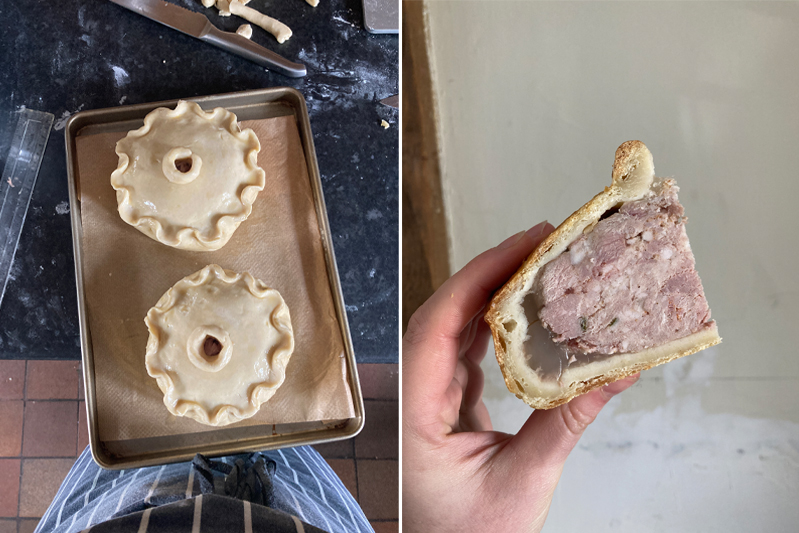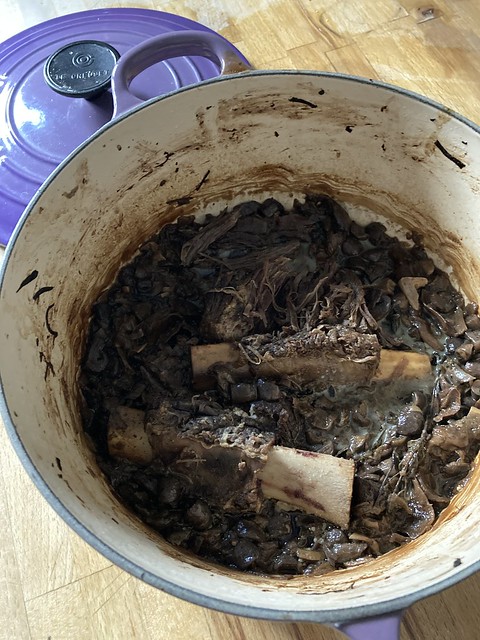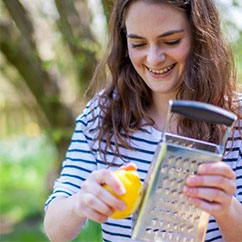What I Learned Attending Virtual Pastry School at River Cottage

This post was created in partnership with Learning With Experts. Hello, my name is Rachel, I have been a professional recipe developer for eight years and I’m still terrified by the idea of making pastry.
I have never been good at making pastry. My hands are too warm, I can never get it to roll out without cracks, it always falls apart or breaks when I try to get it into a tin. While I’ve mastered many more complex kitchen and culinary techniques, being able to make good pastry that is not of the choux variety, that has always alluded me. I pretty much always avoid anything that involves making my own, relying on packet pastry instead.
So, when I was asked if I wanted to take a virtual course to review on online learning platform Learning With Experts, I pushed past the temptation to stay in my comfort zone and try my hand at fermenting or regional Indian cuisine and enrolled in The Pie Shop, River Cottage’s pie-focused savoury pastry section pulled from their cooking diploma.
Each course on the site is a little different (they also offer gardening courses partnering with the Royal Horticultural Society and the Society of Professional Landscape Gardeners, floristry courses, photography, just as examples) but the general idea is you can sign up as an expert or a peer – each course has an online classroom where you can chat and share assignments with your classmates, and on the expert version you also get feedback from your tutor as well as the chance to direct message them with any issues. Once you’ve ordered a course you’re free to start whenever and work at your own pace, but on the tutor options you only have tutor access for a set period of time – on the pie course I had a month to chat with the tutor across all four classes and assignments.
Oh, yes, and please ignore the fact that in all these pictures my kitchen is only half finished, we still need to measure up for the worktops and it can’t be re-painted and the backsplash tiled until that is in!
Lesson 1: Hot Water Pastry
More than anything, this was the lesson I was most excited about. Hand raised pork pies, complete with a homemade pork filling and jelly. I think that nailing this one provided a bigger sense of achievement than the rest of the assignments put together.
So, for each lesson you’re provided with a video of your tutor talking you through the task, plus a few other recipes to get you going with the pastry you’ve made for some of the easier pastries. Then, you get a download which includes the basic recipes (too basic to follow by themselves, you do need the videos) and your assignments at the end; for this task, it was to make two pork pies. For each class I watched the video, then had it open again as I did my assignments. These are submitted in text and photo form; most people (me included!) wrote a paragraph or two to go with phone snaps snapped at each stage of the pastry making.
So, one of my pies was a triumph, but the other split in the oven and went everywhere. One downside of learning like this is I needed to go elsewhere for troubleshooting help while I was actually trying to save my pie, but I got another good SOS tip to put the pie in the fridge for a bit to strengthen it before trying to add jelly it you do get a few holes when my assignment was marked.
Okay, so it took me all day to do, but these pies were delicious and provided wonderful lunches for a good week. I can’t stop looking at pictures of my good pie; I’m really glad this class has taught me how to make them, because while I’ll not make them regularly the hot water crust is something I’m sure I’ll use for future occasions like celebratory outdoor lunches and picnics, because store bought pies of this style I’ve found can be really disappointing. The lesson also taught me that hot water crust pastry is not as hard to make as it looks in cookbooks!
Lesson 2: Rough Puff Pastry
Everyone has watched rough puff pastry be made on The Great British Bake Off, but when I conducted an Instagram poll, only about eight people had bothered to make their own. You’ll pry my stash of frozen puff pastry out of my cold, dead hands, but I’m really pleased to have discovered that it is pretty easy to make myself, and something perhaps I’ll do again for a special occasion dish, like, say, how one in every twenty five lasagnas I make I bother to make the pasta sheets from scratch rather than buying them in.
While the lesson taught a few tarts and cheese straws, I chose to go with the classic sausage roll for my assignment. My pastry was rolled out a little thin (that was my own fault, I made it a few days in advance and did not wrap it well enough in the fridge so I had to cut off the dried out bits before rolling which left me with not quite enough pastry!) but it was beautifully flaky. I also can’t believe before taking the class I’d never thought to top my homemade sausage rolls with a scattering of whole spices and sea salt flakes before baking which was a really nice touch.
Lesson 3: Shortcrust Pastry
This is always where – and where I did – become unstuck. I’m bad at shortcrust. For a few years I used to make French strawberry tarts as a summer dinner party dessert and I always had my Mum make my pastry shells for me (though I’ve not made it since that one luncheon it was far too hot and my creme pat did not set and ran everywhere when it was sliced…) and my five star quiche recipe on BBC Food? Yeah, that is our family shortcrust recipe that I’ve watched my Mum turn out perfect every time, but I usually have to heavily patch once it is in the pastry dish…
This was the one class and assignment I really did not enjoy. First, watching through the video I was worried as it was a pastry recipe using eggs and a method I’d not encountered before. Dutifully I followed it to the letter, struggled as I’d predicted, overworked the pastry which meant it fell to pieces trying to get it into the tin, and tasted really dry and tough after the blind bake, and would not patch. Honestly, I had a horrible time, and did not even get to the part of the assignment where it could be filled.
However, I still learnt something. First, rather than just using your rolling pin to lift the pastry onto your tin, you can roll it right around the pin so it does not break in transit. And the second thing? When you have a pastry recipe, if you struggle with it, stick with what you know and don’t try and mess around. Even trying a new recipe, don’t make their pastry, make yours. I’m going to try making a leek tart recipe I’ve had my eye on for dinner next week, using my / my Mum’s recipe for the pastry, but using that rolling pin method, as well as a tip to roll with rather than across cracks to stop them deepening and see how I get on.
Lesson 4: Suet Pastry
Things finished off with a delicious dinner that was the result of our final class with a suet pudding; something slap bang in the middle of my comfort zone, something I’d been planning to make at some point and something I’m very glad I’ve now got under my belt.
Suet, to me, is something to make really delicious dumplings with, and the suet pastry we made tastes just like a good, fluffy dumpling. I was really pleased to be taught how to make a steamer out of a saucer and a big lidded saucepan, and that I can make a suet pudding in any heatproof glass bowl without having a special pudding basin like my mother does. I went slightly off piste with the assignment making a short rib and porcini mushroom filling I’ve been working on instead of lamb (if I’d used the lamb I had in the fridge you would not have got my Aloo Gosht recipe last week!) and it worked beautifully.
As you can see from the pictures, while I did seal the edges with egg, my pudding stuck to the basin, so the lid came off. However, doing a bit of research now I’ve got the confidence to actually make a suet pudding at home I’ve found that the traditional WI method is to butter the bowl as well as just flour the pastry well, so I’ll try that method next time and hopefully be able to turn out my pudding properly!
My Conclusions
So, was taking a virtual cookery course as good as taking one in real life? I honestly don’t know. It was different, and it really depends what you want to get out of it. While shortcrust pastry and I are still enemies I’m really, really glad something prompted me to finally make my own rough puff, and to try out making hot water crust and suet which are pastries I don’t know what would have prompted me to try myself.
What I did like is I could work at my own pace around my own schedule, particularly good for those of you towards the end of this third (and hopefully final!) lockdown looking to do something for themselves but still have work from home and other family commitments to juggle. If this is you, I would suggest going for the peer option without the tutor help – the videos are excellent, even if you leave a long time between them, and one of my frustrations was I almost ran out of time on tutor contact because of my issues sourcing ingredients and relying only on Ocado deliveries once a week at the moment! Also, all classes are not unlocked at once, so I did not look ahead and get ingredients in stock in just one delivery.
In spite of a few wobbles, I did really enjoy my course and I’d happily do another – since taking my pie course a few more have been uploaded I think look really great and are opportunities to learn from some really fantastic people you just won’t get elsewhere – Gil Meller teaching outdoor cooking, Rachel de Thample teaching fermentation, Michel Roux Jr. teaching the foundations of classical French cookery, and Paul A Young teaching an introduction to chocolate making. And, did I mention you can also send digital gift cards to put towards courses for friends and family who are still a bit too far away for physical presents at the moment?
If you sign up to your first course using this link you can get 20% off – I’d love to hear if any of your are up for learning a new skill! (FYI this is not an affiliate link, but I will also get 20% off a future course – as well as that cooking on fire one, I have my eye on this foraging course!


























Discussion